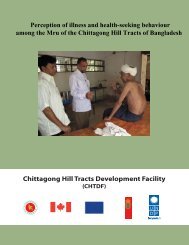Socio-economic Baseline Survey of Chittagong Hill Tracts - chtdf
Socio-economic Baseline Survey of Chittagong Hill Tracts - chtdf
Socio-economic Baseline Survey of Chittagong Hill Tracts - chtdf
- No tags were found...
You also want an ePaper? Increase the reach of your titles
YUMPU automatically turns print PDFs into web optimized ePapers that Google loves.
HDRC<strong>Socio</strong>-<strong>economic</strong> <strong>Baseline</strong> <strong>Survey</strong> <strong>of</strong> <strong>Chittagong</strong> <strong>Hill</strong> <strong>Tracts</strong>242.6.2 Recruitment <strong>of</strong> Listing and <strong>Survey</strong> PersonnelThis activity consisted <strong>of</strong> recruitment and training <strong>of</strong> Enumerator for Households listing andHousehold Listing Supervisors, Field Investigators, Field Supervisors, Quality Control Officers(QCOs), Registration Assistants, Coders, Code Verifiers, Editors and Edit-Verifiers. <strong>Survey</strong>personnel were recruited by inviting and interviewing eligible candidates throughadvertisement among those who were able to make communications in local language <strong>of</strong> CHT.In selecting these personnel, ‘gender equality’ was strictly adhered to. In addition, in selectingthese staff, special preference was given to those having past experience in field data collection.The interviewing committee was headed by the Team Leader. The field staff was recruited intwo steps. In first step, a team <strong>of</strong> highly qualified Field Supervisors (FS) and Quality ControlOfficers (QCO) was recruited at Dhaka from among those who have past experience in thesimilar job in CHT. In second step, in order to ensure compatibility <strong>of</strong> the field team with localtradition and culture, the second part <strong>of</strong> the field team was recruited from all ethniccommunities in CHT. These local field investigators were recruited through TAUNGYA, anon-political voluntary and development organization working in CHT, who worked as localpartner <strong>of</strong> HDRC in this study. All those selected preliminarily were recruited as trainees. Atrainee was finally appointed to the specific post, depending on his/her performance in thetraining. After successful completion <strong>of</strong> training, a total <strong>of</strong> 56-member field team was recruitedfor successful completion <strong>of</strong> the field data/information collection process. The field teamcomprised <strong>of</strong> 41 field investigator, 10 field supervisors, and 5 quality control <strong>of</strong>ficers. On theother hand, ethnicity balance <strong>of</strong> field team was maintained. The strategic strength <strong>of</strong> FieldTeam was the participation <strong>of</strong> all communities which captured the socio-cultural diversities andheterogeneous features <strong>of</strong> CHT population. This model <strong>of</strong> recruitment, training and field datacollection by involving indigenous peoples and by mentioning ethnicity balance has been, byitself, a great learning because it (a) enhanced greater mutual understanding betweenindigenous peoples and Bangalees, and (b) built capacity <strong>of</strong> the data collectors– bothindigenous peoples and Bangalees in the CHT (many <strong>of</strong> whom got the chance first time in theirlife).2.6.3 Training <strong>of</strong> Field PersonnelTraining must be considered as a crucial phase for successful and quality data collection. Inthis regard a rigorous training was provided to all the types <strong>of</strong> field personnel including FieldSupervisors, Quality Control Officers and Field Investigators for 8 days (from 30 December2007 to 06 January 2008). Training was imparted on the whole data collection instrument andquality control issues. To ease the training process as well as to build solidarity amongtrainees drawn from all ethnic groups, residential training arrangement was made for thetrainees. There was separate training for <strong>Survey</strong> teams and In-house (coding, editing,registration) teams. The topics <strong>of</strong> training for survey team included, among others, an overview<strong>of</strong> the study, overall objective <strong>of</strong> the study, data collection instruments, sample drawingtechniques, techniques <strong>of</strong> rapport building and interviewing. In training, both quantitative andqualitative tools were addressed. Training was conducted through classroom lectures,demonstration interviews, role playing, field practice, review <strong>of</strong> lessons learned and suggestedsolutions. The training was imparted by the members <strong>of</strong> the study team under close guidancefrom and supervision <strong>of</strong> the <strong>Socio</strong>-economist, Pr<strong>of</strong>essor Abul Barkat. To assess the capacityachieved by field personnel one demonstration interview and two field practices wereconducted. To develop the ownership sense <strong>of</strong> the study among the field personnel and boostup their mind-set to take the challenge <strong>of</strong> field activities and to draw proper attention and



